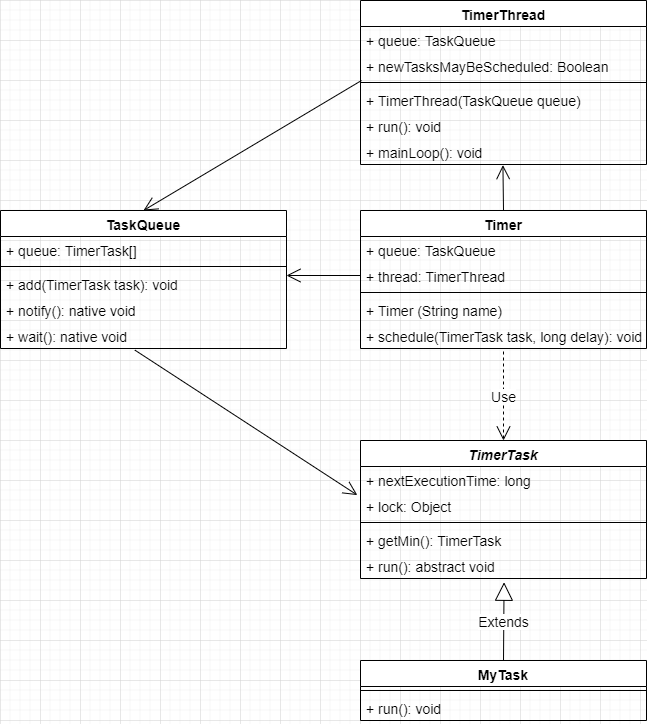这篇文章主要介绍“Java任务调度Timer定时器怎么实现”,在日常操作中,相信很多人在Java任务调度Timer定时器怎么实现问题上存在疑惑,小编查阅了各式资料,整理出简单好用的操作方法,希望对大家解答”Java任务调度Timer定时器怎么实现”的疑惑有所帮助!接下来,请跟着小编一起来学习吧!
Timer任务调用相关类的UML图如下(仅包含部分变量与方法):

使用时,需自己写一个类,继承TimerTask,重写run()方法,大致步骤如下:
1.Timer的成员变量thread初始化时会聚合queue
public class Timer {
/**
* The timer task queue. This data structure is shared with the timer
* thread. The timer produces tasks, via its various schedule calls,
* and the timer thread consumes, executing timer tasks as appropriate,
* and removing them from the queue when they're obsolete.
*/
private final TaskQueue queue = new TaskQueue();
/**
* The timer thread.
*/
private final TimerThread thread = new TimerThread(queue);2.Timer构造方法有几个重载,最终会调用thread的start()方法,启动线程,调用run()方法
public Timer(String name) {
thread.setName(name);
thread.start();
}3.thread的run()方法核心逻辑为mainLoop()方法:如果queue中TimerTask[]为空 && newTasksMayBeScheduled = true,则queue.wait()进入阻塞状态
private void mainLoop() {
while (true) {
try {
TimerTask task;
boolean taskFired;
synchronized(queue) {
// Wait for queue to become non-empty
while (queue.isEmpty() && newTasksMayBeScheduled)
queue.wait();
if (queue.isEmpty())
break; // Queue is empty and will forever remain; die
// Queue nonempty; look at first evt and do the right thing
long currentTime, executionTime;
task = queue.getMin();
synchronized(task.lock) {
if (task.state == TimerTask.CANCELLED) {
queue.removeMin();
continue; // No action required, poll queue again
}
currentTime = System.currentTimeMillis();
executionTime = task.nextExecutionTime;
if (taskFired = (executionTime<=currentTime)) {
if (task.period == 0) { // Non-repeating, remove
queue.removeMin();
task.state = TimerTask.EXECUTED;
} else { // Repeating task, reschedule
queue.rescheduleMin(
task.period<0 ? currentTime - task.period
: executionTime + task.period);
}
}
}
if (!taskFired) // Task hasn't yet fired; wait
queue.wait(executionTime - currentTime);
}
if (taskFired) // Task fired; run it, holding no locks
task.run();
} catch(InterruptedException e) {
}
}
}4.阻塞状态下,调用Timer类的schedule方法开启定时任务,schedule有几个重载,最终都是调用sched方法
5.sched方法中,queue.add(task),然后queue.notify()唤醒thread的线程
private void sched(TimerTask task, long time, long period) {
if (time < 0)
throw new IllegalArgumentException("Illegal execution time.");
// Constrain value of period sufficiently to prevent numeric
// overflow while still being effectively infinitely large.
if (Math.abs(period) > (Long.MAX_VALUE >> 1))
period >>= 1;
synchronized(queue) {
if (!thread.newTasksMayBeScheduled)
throw new IllegalStateException("Timer already cancelled.");
synchronized(task.lock) {
if (task.state != TimerTask.VIRGIN)
throw new IllegalStateException(
"Task already scheduled or cancelled");
task.nextExecutionTime = time;
task.period = period;
task.state = TimerTask.SCHEDULED;
}
queue.add(task);
if (queue.getMin() == task)
queue.notify();
}
}6.therad的run()继续执行,进行一系列判断,最后调用TimerTask的run()方法,执行定时任务(见mainLoop方法)
到此,关于“Java任务调度Timer定时器怎么实现”的学习就结束了,希望能够解决大家的疑惑。理论与实践的搭配能更好的帮助大家学习,快去试试吧!若想继续学习更多相关知识,请继续关注亿速云网站,小编会继续努力为大家带来更多实用的文章!
免责声明:本站发布的内容(图片、视频和文字)以原创、转载和分享为主,文章观点不代表本网站立场,如果涉及侵权请联系站长邮箱:is@yisu.com进行举报,并提供相关证据,一经查实,将立刻删除涉嫌侵权内容。